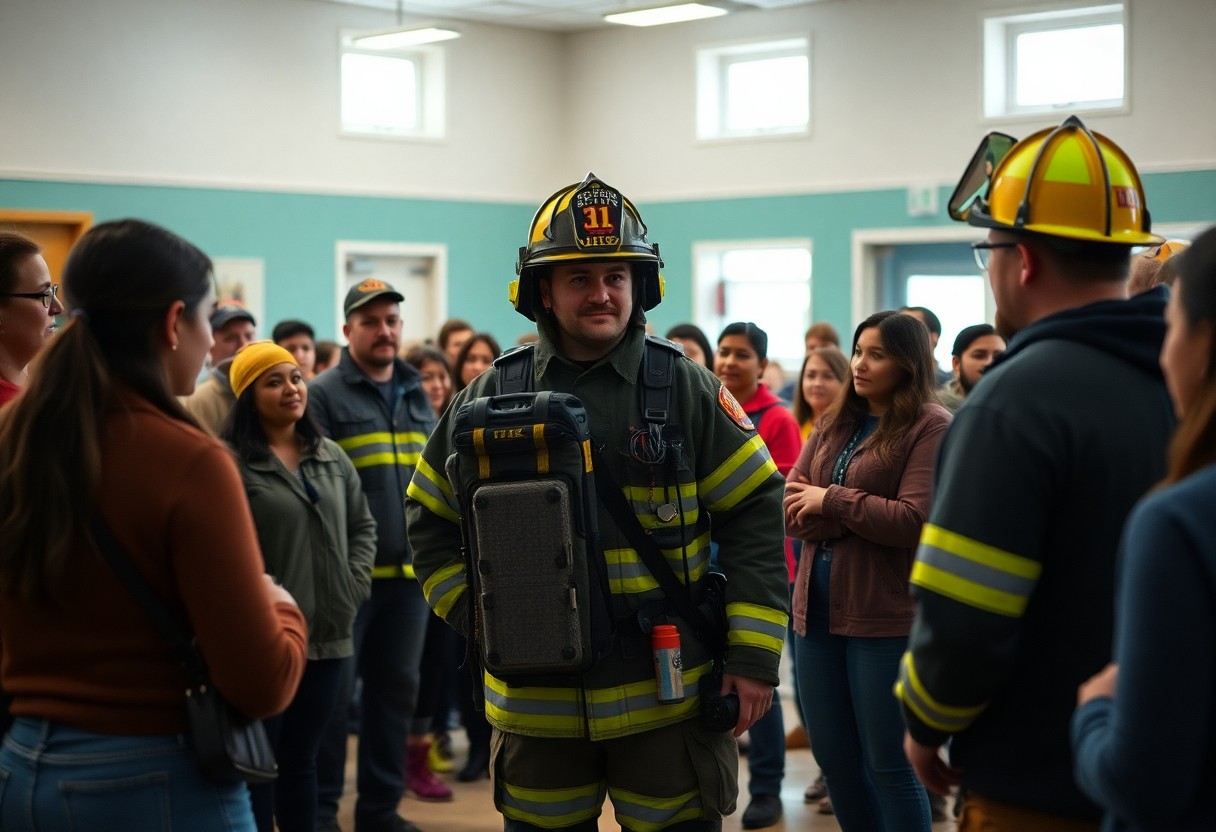Most people in your community may not fully understand the skills and training required for volunteer firefighting, which can create barriers to recruitment. By offering free classes, you can provide valuable education that not only enhances public safety but also showcases the rewarding aspects of serving in this vital role. In this post, you will discover how these classes can effectively engage potential recruits, foster community connection, and ultimately strengthen your volunteer firefighting department.
Understanding Volunteer Firefighting
While volunteer firefighting plays a vital role in many communities, it often relies on the passion and dedication of individuals who are willing to serve without financial compensation. These departments are typically staffed by members of the community who are trained to respond to emergencies, providing crucial services like firefighting, rescue operations, and medical assistance. Engaging in volunteer firefighting is not only about emergency response; it cultivates a sense of camaraderie and commitment to public safety within your community.
The Importance of Community Engagement
Along with providing crucial services, community engagement fosters a strong connection between volunteer firefighters and the residents they serve. By offering free classes or events, you can create opportunities for community members to learn about firefighting, emergency preparedness, and safety measures. This involvement strengthens relationships, promotes awareness of fire risks, and encourages more individuals to consider joining your department.
Benefits of Volunteer Firefighters
On top of enhancing public safety, volunteer firefighters bring numerous benefits to your community, including cost savings and a robust emergency response network. By relying on volunteers, fire departments can allocate their limited resources more efficiently, maintaining equipment and infrastructure while ensuring immediate response during emergencies. Furthermore, these dedicated individuals help build trust and a sense of belonging within the community, making it more resilient and united during challenging times.
Even beyond the immediate advantages, the presence of volunteer firefighters can foster a culture of safety and preparedness in your community. Through training and educational opportunities, you empower residents to take an active role in their safety and well-being. This not only decreases the risk of fire-related incidents but can also encourage those who may not have considered volunteering to step forward and contribute to their community’s safety infrastructure. Overall, engaging volunteers strengthens the fabric of your community while ensuring a rapid and effective response in times of crisis.
The Concept of Free Classes
There’s an emerging trend among volunteer firefighting departments to offer free classes tailored for the community. This strategy not only fosters a deeper understanding of fire safety but also serves as a recruitment tool to attract potential new members. By engaging your community with valuable educational opportunities, you create a positive perception of your department, showcasing your dedication to public service and community well-being.
Types of Classes to Offer
Classes can be a mix of practical skills and knowledge-sharing, enriching the community’s awareness and involvement. You might consider the following:
- Fire Safety Education
- Basic First Aid and CPR
- Disaster Preparedness Training
- Hands-on Fire Extinguisher Training
- Youth Firefighter Programs
Recognizing the varying interests can lead to a tailored approach that benefits both your department and the community.
| Class Type | Description |
| Fire Safety Education | Learn vital fire prevention tips. |
| Basic First Aid and CPR | Gain life-saving skills applicable in emergencies. |
| Disaster Preparedness Training | Prepare yourself for natural disasters. |
| Hands-on Fire Extinguisher Training | Practice using fire extinguishers safely. |
| Youth Firefighter Programs | Engage young individuals in firefighting basics. |
Potential Audience for Classes
Classes can effectively reach a diverse audience, expanding your department’s influence and potential recruitment base. By identifying groups within your community that might benefit from these teachings, you enhance engagement and foster relationships.
For instance, families, schools, and local organizations can serve as excellent avenues to promote your free classes. Engaging schools can lead to workshops focused on fire safety, while local organizations may assist in spreading the word. By targeting various community sectors, your reach broadens, and those interested in volunteering may come forward with newfound knowledge and motivation. This approach paves the way for stronger community ties and possible recruitment for your volunteer firefighting team.
Impact on Recruitment Efforts
Any effort to enhance recruitment in volunteer firefighting departments should leverage community engagement initiatives, such as offering free classes. By promoting fire safety, you increase awareness of the department’s mission and showcase the rewarding opportunities available. This strategy attracts diverse individuals who might not have considered volunteering previously, thus expanding your recruitment pool and invigorating the department.
Building Awareness and Interest
Impact your community by hosting free classes that raise awareness about fire safety and the role of volunteer firefighters. These classes not only educate participants but also highlight the importance of the department, creating a direct connection to its mission. You foster a culture of curiosity and involvement, which naturally leads to increased interest in joining your team.
Strengthening Community Relationships
By engaging with your community through free classes, you build stronger relationships that foster trust and collaboration. Establishing these connections can be a game changer in bolstering recruitment efforts. As participants learn about firefighting and safety, they form a sense of camaraderie that can motivate them to consider volunteering.
To truly strengthen relationships, focus on creating a welcoming environment where community members feel comfortable and valued. Engage them through hands-on activities and open discussions that emphasize teamwork and shared goals. These connections reinforce your department’s visibility and credibility, making it more appealing for potential volunteers to join your ranks. Ultimately, you create a supportive network that benefits both the community and the firefighting department.
Case Studies and Examples
After examining various fire departments that have implemented free classes, some noteworthy outcomes include:
- City A experienced a 25% increase in volunteer applications within six months of launching their free CPR training.
- Town B saw a 40% retention rate among new recruits who attended their introductory firefighting skills workshop.
- County C improved community engagement by 30%, with more local families participating in safety seminars and events.
- Department D noted that 60% of new volunteers participated in their free fitness training program, leading to enhanced team performance.
Successful Programs Across the Nation
Above all, communities that offer accessible training programs tend to create a more active volunteer pool. For instance, fire departments in Texas and California have reported positive feedback from families who value the educational opportunities provided. This fosters a sense of loyalty and turns community members into trained volunteers ready to serve when needed.
Lessons Learned from Implementations
Learned from various implementations, it’s clear that offering free classes goes beyond just recruitment; it nurtures a community spirit. Programs should be tailored to suit the demographic and interests of the area, ensuring inclusivity and engagement. Regular feedback from participants can enhance these programs, improving retention rates and overall satisfaction.
Understanding the significance of community involvement is key to reinforcing your volunteer firefighting department. By analyzing what worked in different scenarios, you can refine your approach. Community feedback helps you adapt programs that resonate with local values and needs, resulting in a sustainable cycle of learning, engagement, and recruitment in your firefighting initiatives.
Challenges and Considerations
Once again, while offering free classes to your community may seem like an appealing strategy for recruiting volunteers for your fire department, it’s important to acknowledge the challenges and considerations that accompany this initiative. You will need to ensure that you have enough trained instructors, secure adequate facilities, and develop a structured program that addresses various community needs. Additionally, you’ll need to balance your current operational demands with the resources required for these classes to avoid overstretching your department.
Resource Allocation and Funding
The success of your free training classes hinges on effective resource allocation and funding. You will need to assess whether your department has the financial backing to cover materials, instructor costs, and promotional efforts. It may be necessary to explore grants or local sponsorships to provide the necessary support and ensure that the initiative does not divert funds from ongoing operations.
Measuring Success and Impact
Resource allocation is only one part of the equation; assessing the effectiveness of your training programs is equally pivotal. You must develop metrics and evaluation methods to measure how these classes impact both community involvement and volunteer recruitment. Surveys, attendance rates, and feedback can be instrumental in gauging the success of your initiative.
In fact, establishing clear benchmarks will help you identify areas for improvement and validate the effectiveness of your community classes. By closely monitoring these parameters, you can create an evolving program that continuously meets the needs of both potential volunteers and your fire department. This ongoing evaluation not only enhances recruitment efforts but also fosters community engagement, reinforcing the importance of your department within the community.
Future Trends in Fire Department Recruitment
To remain competitive and effective in attracting volunteers, fire departments must adapt to the evolving landscape of recruitment strategies. As communities become more diverse and technology-driven, embracing new methods and approaches will be vital. By integrating innovative practices and community engagement, you can enhance your recruitment efforts and build stronger connections with potential recruits.
Incorporating Technology and Social Media
Any recruitment strategy must now include technology and social media platforms to reach potential volunteers effectively. Utilizing these tools allows you to showcase your department’s value while engaging with your community in real-time. Sharing success stories, upcoming events, and relatable content can help attract a broader audience and encourage participation.
Expanding Class Offerings and Opportunities
At the heart of community engagement is the opportunity for you to expand class offerings and training opportunities. By diversifying the types of courses available, such as fire safety, first aid, and leadership training, your department can appeal to a wider range of individuals, from those seeking personal development to those looking to serve their community. This increases your pool of potential volunteers, making it easier to find individuals whose interests align with your department’s mission.
Plus, providing accessible classes allows you to cater to different schedules and preferences, making it easier for community members to participate. By offering both in-person and virtual options, you can ensure that anyone interested can find a program that fits into their life. Expanding your class topics and structures not only enhances your engagement but also fosters a sense of belonging and commitment among potential volunteers, paving the way for a dedicated fire department team.
Conclusion
Summing up, offering free classes to your community can significantly enhance your volunteer firefighting department’s recruitment efforts. By providing valuable training, you create a supportive environment that not only raises awareness about firefighting but also fosters a sense of belonging among potential recruits. Engaging with your community in this way demonstrates your commitment to public safety and encourages individuals to consider volunteering. Ultimately, this investment in education can lead to a stronger, more capable volunteer force ready to respond when needed.



